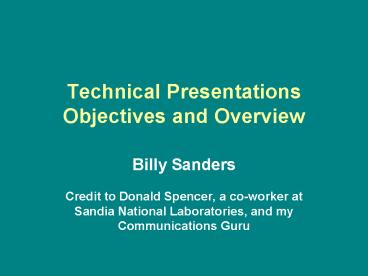Technical Presentations Objectives and Overview - PowerPoint PPT Presentation
1 / 29
Title:
Technical Presentations Objectives and Overview
Description:
Technical Presentations. Objectives and Overview. Billy ... Analysis Narration. III. Organizing the Content. CHECK EACH SUBSECTION. Adequate Development? ... – PowerPoint PPT presentation
Number of Views:38
Avg rating:3.0/5.0
Title: Technical Presentations Objectives and Overview
1
Technical PresentationsObjectives and Overview
- Billy Sanders
- Credit to Donald Spencer, a co-worker at
- Sandia National Laboratories, and my
- Communications Guru
2
Advancement of Scienceand Technology
- Depends on
- Solving Problems
- Communicating
3
Designing the Oral Presentation
- I. Consider Advantages/Limitations
- of Speech vs. Writing
- II. Analyze the Dynamics
- III. Organize the Content
- IV. Design the Visual Aids
4
I.Speech vs. Writing
- THE BASICS
- Speech Writing
- uses uses
- Language Language
5
I.Speech vs. Writing
- INHERENT CHARACTERISTICS
- Speech is Writing is
- primary derived
- continuous fixed
- augmented single
- interactive solitary
- immediate delayed
6
I.Speech vs. Writing
- LIMITATIONS OF SPEECH
- Being Remembered
- Fixing Patterns
- Giving Detail
- Describing Appearances
- Treating Complexities
7
I.Speech vs. Writing
- ORAL PRESENTATION
- We use it when we want to
- Secure a quick response
- Capitalize on personal impact
- Be persuasive
- Answer questions on the spot
- Meet crises demanding immediate action
- Promote personal image and prestige
- Establish and maintain personal-level relations
- Engage in deliberations leading to decisions
8
II.Analyzing the Dynamics
- CONSIDERATIONS
- Subject
- Purpose
- Audience
9
II.Analyzing the Dynamics
- SUBJECT
- Limit?
- Focus?
- Context?
- Handout?
10
II.Analyzing the Dynamics
- DECIDE YOUR PURPOSE
- Giving Information?
- or
- Persuading?
11
II.Analyzing the Dynamics
- CONSIDER THE AUDIENCE
- How Large?
- How Diverse?
- How Knowledgeable?
- How Predisposed?
- How Do They Regard Me?
- What Do They Expect?
12
III.Organizing the Content
- MAJOR STEPS
- Define Subject
- Divide
- Order
- Subdivide
- Develop
- Introduce, Conclude
13
III.Organizing the Content
- DEFINE YOUR SUBJECT
- Adapt to --
- Purpose
- Audience
- Write It Out
14
III.Organizing the Content
- DIVIDE THE SUBJECT INTO
- 2, 3 or 4 Major Sections
- Use a Logical Scheme
- Time Order
- Order of Importance
- Spatial Distribution
- Cause-Effect
- Something Else?
- Parts Should Be
- Of Equal Size and Importance
- Have a Distinct Focus
- Provide Complete Coverage
15
III.Organizing the Content
- DECIDE THE ORDER
- Criteria --
- Consider Your Logical Scheme
- Decide Order of Importance
- Where do You Want Audience Focus
- Consider Memorability
- Consider Acceptability
16
III.Organizing the Content
- SUBDIVIDE MAIN SECTIONS
- 2-5 Subsections Max.
- Avoid Further Subdivision
- Re-examine --
- Subject Limitation
- Focus
- Purpose
- Logic Scheme
- Consider Handouts
17
III.Organizing the Content
- DEVELOPMENT
- Arrange in Subsections
- Facts Illustrations
- Data Examples
- Observations Quotations
- Argument Comparisons
- Analysis Narration
18
III.Organizing the Content
- CHECK EACH SUBSECTION
- Adequate Development?
- Excess Material?
- Redundancy?
- Revise Accordingly
19
III.Organizing the Content
- INTRODUCTION
- Defines --
- Subject
- Purpose
- Treatment
- Scope
- Context
- Provides --
- Filing System for Brain
- Initiates Interaction
20
III.Organizing the Content
- CONCLUSION
- May Summarize Important Points
- May List Conclusions
- Re-stresses Central Theme
21
IV.Designing the Visual Aids
- TWO BASIC TYPES
- VERBALS Print A Few Lines
- PICTORIALS Everything Else
22
IV.Designing the Visual Aids
- PUT ON VERBALS
- Structural Cues --
- Orient the Audience
- Provide Information Filing System
- Supporting Information --
- Memory Joggers
- Items for Emphasis
23
IV.Designing the Visual Aids
- LANGUAGE
- Be Consistent
- Use Similar --
- Parts of Speech
- Word Order
- Verb Tense
24
IV.Designing the Visual Aids
- USE VIGOROUS LANGUAGE
- Prefer -- Avoid --
- Positive Cliches
- Specific Jargon
- Nouns,Verbs Esoterica
- Active Exotica
25
IV.Designing the Visual Aids
- CUT PUNCTUATION TO THE BONE
- MINIMIZE WORD, LINE COUNT
- Words lt 25, Lines lt 12
- Too Many Too Much
- Words ? Reading
26
In Summary
- FOLLOW THE FOUR BASIC STEPS
- to
- Designing the Oral Presentation
- I. Consider Speech Vs. Writing
- II. Analyze the Dynamics
- III. Organize the Content
- IV. Design the Visual Aids
27
ORAL PRESENTATION
- Tool for Interaction
- No Substitute for Writing
- -- Therefore --
- Adapt to Conditions
- Capitalize On Inherent Strengths
- Make Visuals Serve
28
Other Advice
- Carefully plan your talk, it removes anxiety!
- Practice your talk to improve delivery!
- Don't worry about being nervous!
- Relax!
- Try to have fun!
29
Lets analyze a few examples































